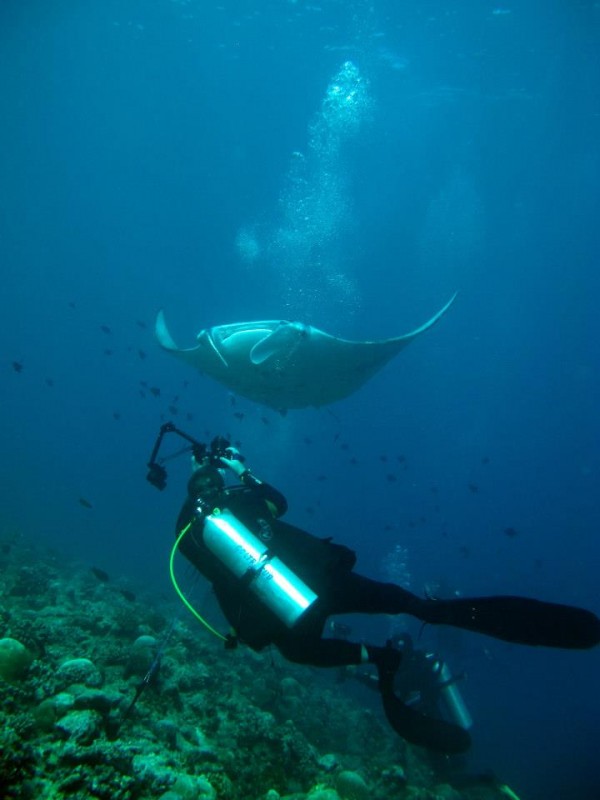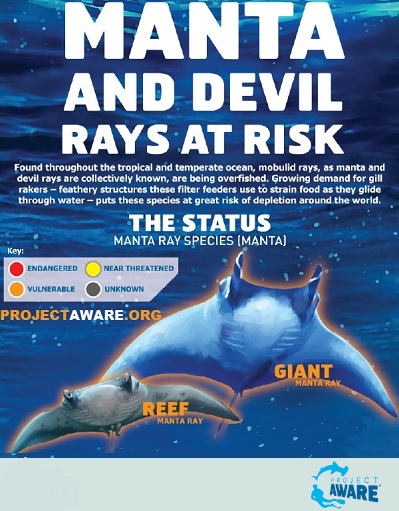Demand for Gill Plates Threatens Manta Ray Tourism Dollars for Local Communities

New study focuses on conservation as revenue generator.
The demand for manta ray gill plates, US$5M globally, is greatly outweighed by the estimated US$140M raised annually through manta ray tourism according to a new study from leading wildlife conservationists. The study, conducted by researchers from WildAid, The Manta Trust, and Shark Savers, is the first to estimate the economic impact of manta ray ecotourism at the global level. The Global Economic Impact of Manta Ray Watching Tourism was published today in the PLoS ONE open access journal.
The study features data collected from 23 countries around the world, with tour operators advertising manta ray watching identified in a further eight countries.
In total, 10 countries accounted for nearly 93% of the global expenditure estimate: Japan, Indonesia, the Maldives, Mozambique, Thailand, Australia, Mexico, the United States, the Federated States of Micronesia, and Palau.
“While hunting manta rays for their gill plates is fairly new, arising in the past 15 years, it poses a substantial threat to the survival of manta ray populations,” said Mary O’Malley, lead author of the study. “As an example in Indonesia, revenue to fishermen from manta gill plates is estimated at roughly $400,000, while manta tourism brings in over $15 million in revenue to communities that can continue year after year without depleting manta populations.”
 While fisheries for most species strive to harvest the maximum number of fish each year without depleting the population, this study advises further exploration of non-consumptive tourism given manta rays’ very low reproductive rates, estimated at a maximum of only 16 pups in a lifetime.
While fisheries for most species strive to harvest the maximum number of fish each year without depleting the population, this study advises further exploration of non-consumptive tourism given manta rays’ very low reproductive rates, estimated at a maximum of only 16 pups in a lifetime.
“All of the operators who responded to our surveys considered manta rays to be important to their businesses and the local communities, and a number of them expressed concerns that declines in manta ray populations would negatively impact their businesses,” said Hannah Medd, Marine Biologist for Shark Savers.
“With some investment into infrastructure and proper management, manta tourism offers enormous potential to protect these amazing animals while improving the lives of coastal communities,” added Katie Lee-Brooks, Director of Operations at the Manta Trust.
Due to the vulnerability of manta rays to increased fishery pressure driven by the gill plate trade, the 178 parties to Convention on International Trade in Endangered Species of Wild Fauna and Flora (CITES) voted this March to strictly regulate the international trade in both species of manta, the reef manta ray (Manta alfredi) and the giant manta ray (Manta birostris).
This study built upon preliminary estimates of manta ray tourism expenditures included in the 2011 Manta Ray of Hope report, The Global Threat to Manta and Mobula Rays. The authors of the study wish to acknowledge the assistance and co-operation they received from operators involved in this study as well as researchers in Japan (Tom Kashiwagi and dive operator Takashi Ito), Hawaii (Manta Pacific Research Foundation), Yap (Bill Acker), and Western Australia (Frazer McGregor) who contributed valuable data and estimates.
The open access report is available on PLoS ONE.
This study should be cited as: O’Malley MP, Lee-Brooks K, Medd HB (2013) The Global Economic Impact of Manta Ray Watching Tourism. PLoS ONE 8(5): e65051. doi:10.1371/journal.pone.0065051
Photo courtesy of Karine Poch, Aquatile Plongée



